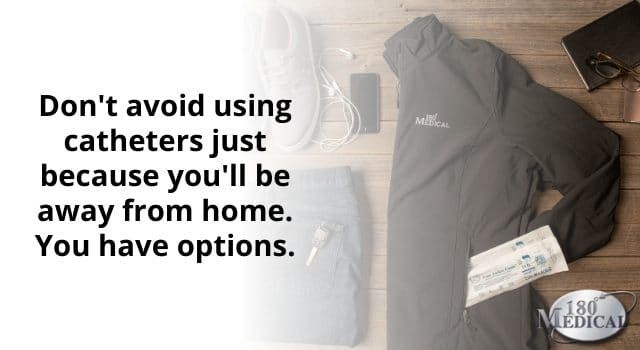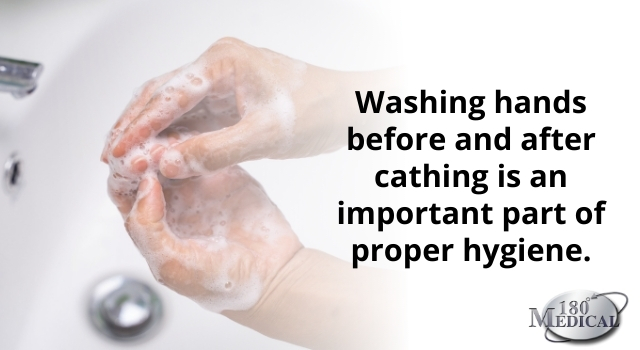
If you’re new to using catheters, it’s natural to feel a little worried about catheterizing away from the comfort of your home. Maybe you’re preparing for your first vacation after your new diagnosis, or you’re ready to return to work. We understand that catheterizing in public restrooms can present some unique challenges.
For example, you may wonder how you can discreetly carry catheters or have anxieties about maintaining proper hygiene away from home. In this guide, 180 Medical offers practical tips to help you feel more confident about using catheters in public restrooms.
Tips for Catheterizing in Public Restrooms
Catheterizing away from home doesn’t have to be a stressful experience. Whether traveling, at work, or running errands, it’s all about staying prepared. Let’s walk through some expert tips that can help make using catheters in public restrooms easier and more discreet.
Learning how to cath in public places is a necessity because you won’t always be at home in the comfort of your own bathroom when it’s time to self-cath.
Tip 1. Always follow your prescribed cathing schedule.
Some people try to avoid using catheters while they’re away from home. While skipping a few catheterization times may seem like it’s fine, the truth is that holding urine in the bladder for too long may cause complications. It can even damage your bladder or cause leakage.

No matter where you are, when it’s time to self-cath, you need to find a restroom or a private place and make it happen. Talk to your prescribing doctor if you’re not sure how many times per day you’re supposed to catheterize.
Tip 2. Make a plan for carrying your catheter supplies.
When planning to cath away from home, whether traveling or going to school or work, you have different ways of discreetly and easily transporting your catheters.
Discreetly Tote A Catheter in Your Pocket
If you use an uncoated catheter, pre-lubricated catheter, or hydrophilic catheter, you may be able to fold the catheter package into a soft U-shape or even wrap it into a circle shape to store in your pocket. Just make sure the catheter doesn’t kink.
Cure™ catheters, one of the many top-quality catheter brands we offer at 180 Medical, are made with high-quality materials, so the catheter tube will not kink when bent or folded.
Use a Pocket Catheter or Travel Catheter
180 Medical offers a wide variety of discreet pocket catheters, including compact catheters from leading brands. These smaller, easy-to-use options can make using catheters in public restrooms more discreet and convenient.
Store Your Catheters in a Bag
If you are out and about during your day away from home, consider using a backpack, purse, fanny pack, or a briefcase to store your catheters discreetly in public.
Steve, 180 Medical Patient Advocate, is a frequent traveler with plenty of experience with catheterizing in public restrooms, including airport bathrooms. When he’s on the go, he likes to carry his catheter supplies in a backpack, which he slips over the back of his wheelchair.
Over the years, we have heard it all from customers. Some people like to put together a special travel pack just for their catheter supplies and other medical supplies. Some like to carry their catheters in zippered money belts or even eyeglass cases.
With time and a little experimentation, you can find what will work best for you if you like to keep your catheter needs discreet and private.
Tip 3. Learn sterile catheterization practices for public restrooms.
You may not encounter as many germs in your home as when using catheters in a public bathroom. Typically, you can wash your hands at the sink, go to your toilet or the area designated for your routine, and prepare your catheter supplies accordingly.
However, in a public restroom, you can’t control how clean the environment is. That’s why keeping the process as sterile as possible is important. This may help lower your risk of contamination and therefore infections, such as urinary tract infections or bladder infections.
180 Medical offers step-by-step tips for catheterization at howtocath.com. Here are a few suggestions that may help.
First, wash your hands.
Before you enter the public restroom stall, be sure to wash your hands thoroughly with soap and water. If you can use a clean paper towel, this is probably a better option than a hand dryer, which may blow more germs back onto your hands.

Use a paper towel or underpad to set your supplies on.
Once in the restroom stall, you likely won’t find a clean surface to set your catheter supplies. Once in the stall, use a clean paper towel or an underpad to create a hygienic surface for your catheter supplies. If there’s no space, consider placing your items in your lap while seated on the toilet or in your wheelchair.
Use antibacterial wipes to clean the area before catheterization.
Make sure your hands are as clean as possible before handling or inserting a catheter. You may also want to use an antibacterial wipe to clean the area of insertion around the urethra or stoma.
If you use a closed-system catheter with a kit of catheter insertion supplies, you’ll likely have some disinfecting wipes or swabs, such as PVP swabs or BZK wipes. Some people like to apply antibacterial gel or hand sanitizer before handling their catheter as an extra precautionary measure. Many people also use gloves, which you can find in many catheter kits.
Incorporating these steps may help reduce the risk of contamination and subsequent infection while cathing in public spaces.
Using an uncoated catheter? Learn how to sterilely lubricate your catheter.
If you use uncoated catheters, you may need to apply lubricant before insertion. This can be a little tricky in public restrooms, but it becomes second nature with practice. Here are two simple methods:
- Use the packaging: Tear open the lubrication packet and hold your catheter’s funnel while running it through the packet’s opening to apply the lubricant evenly.
- Lubricate in the package: Open the catheter packaging partially, squeeze the lubricant inside, and then pull the catheter through the lubricated portion of the packaging as you remove it.
Both of these methods allow for a quick, sterile application of lubricant when you’re on the go.
Try an advanced no-touch catheter.
Depending on your insurance’s catheter coverage, you may be eligible to try out an advanced no-touch catheter, such as a pre-lubricated or hydrophilic catheter. Some of these are ready to use right out of the catheter package, such as the Cure Twist™ Female Catheter.
Many hydrophilic catheters require the application of water, which is often in a breakable sachet along with the catheter, in order for the lubrication coating to activate after waiting anywhere from 15 to 60 seconds. Other hydrophilic catheters instantly activate, like the GentleCath Glide™ Hydrophilic Catheter, which can be helpful when you don’t want to wait.
No-touch catheters come with an insertion sleeve or handling gripper of some kind, which helps you handle and insert the catheter without touching the tube. This can help reduce the risk of infection and contamination from hands, which is great for cathing in public places.
Dispose of your supplies hygienically.
After you’ve finished cathing, you can throw away the used catheter and contents of your used packaging in the nearest trash receptacle. Some catheter options, such as the Coloplast SpeediCath® Flex Coudé Pro Pocket Catheter, offer a way to reclose the package when you’re done for tidy disposal without the mess. You can carry this used pack in your bag or backpack until you’re ready to discreetly throw it away in private.
Lastly, remember never to flush your used catheter supplies down a toilet.
Where to Find Discreet Catheters for Catheterizing in Public Restrooms
Whether you’re ready to find a reliable catheter supplier with a wide selection of brands and options or you want to know more about using your catheters, 180 Medical is here for you.
As a leading catheter company in America, 180 Medical specializes in catheter supplies. We know the catheter industry inside and out, so we can guide you through the process of getting your catheters. Not only do we help you understand your insurance coverage for catheters and fully explain your benefits, but we can also help you find the right type of catheter that will work best for you.
In addition, we want to make sure you fully understand how to safely and comfortably use your catheters. We can even send you full-color brochures and helpful step-by-step instructions for learning how to catheterize with your order or free samples.
Our Catheter Specialists are ready to answer any questions you have about catheter products. We can also help walk you through the cathing process.
Disclaimer: Please note that this is intended to provide a general understanding of sterile catheterization. It should not be used in place of a visit, call, or consultation with a physician or other healthcare provider.
